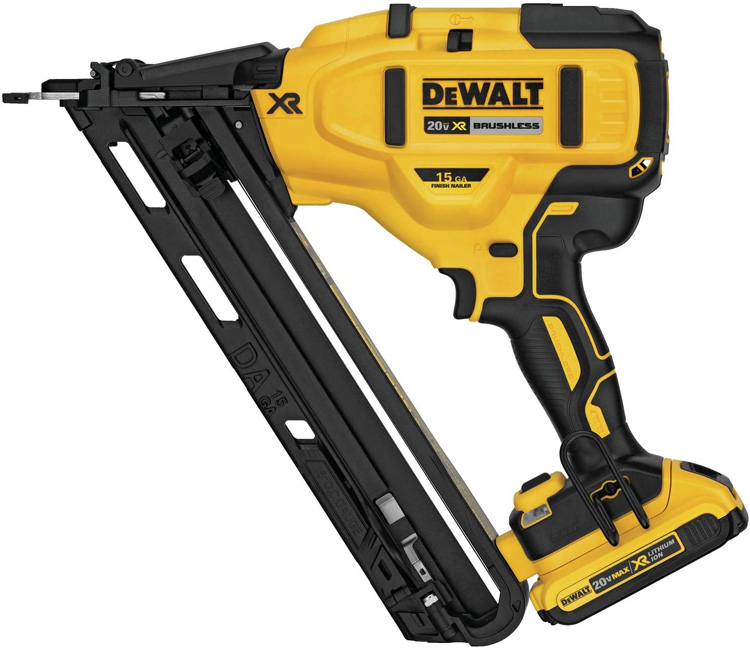Straight vs Angled Finish Nailer (Uses and Key Differences)

As most avid DIY enthusiasts are well aware, it is absolutely essential to have the right tools within arm’s reach, when attempting to complete any task. Doing so allows one to make the most efficient use of their time, without cutting corners or sacrificing quality. This keen attention to detail typically results in a cleaner finished product that one can be proud of for years to come.
When selecting the perfect tool for hanging trim or crown molding, few such instruments carry as much value as the finish nailer. In the hands of a skilled individual, the finish nailer is capable of driving fasteners at a break-neck pace, thereby saving time and reducing hassle. However, selecting the perfect finish nailer for a particular task can be somewhat difficult at times.
Finish nailers come in both straight and angled forms, posing a quandary of sorts for those attempting to determine how best to spend their money. While both types of finish nailers are quite capable in their own right, each is intended to serve a specific purpose.
Read on to learn more about the differences between straight and angled finish nailers, as well as how to choose the perfect finish nailer for your specific needs.
Related: Finish Nailer vs Brad Nailer (Comparison)
What is a Straight Finish Nailer?

A straight nailer is a power tool that sinks specialty nails into various surfaces when called upon to do so with the pull of a trigger.
Straight finish nailers feature standard magazines, of typical inline configuration, and generally use 16-gauge nails. These smaller nails tend to be relatively easy to hide when applied to any number of surfaces.
Straight finish nailers come in numerous forms, including those of both pneumatic and battery-powered varieties. Though pneumatic finish nailers served as the “gold standard” for quite some time, battery-powered finish nailers have now risen to prominence, largely due to their superior portability since they don’t require a compressor, air hose, extension cord, or electrical outlet.
When to Use a Straight Finish Nailer
- Hanging trim
- Installing crown molding
- Working with lighter materials
- Operating in open spaces
What is an Angled Finish Nailer?

Angled finish nailers serve as a variant of the straight finish nailer that features an “angled” magazine. Like their straight magazine counterparts, angled finish nailers disperse specialized nails with each cycle of the trigger.
However, angled finish nailers generally utilize larger nails, up to 15-gauge in size. These larger nails tend to be superior in heavier, construction-type applications. Angled finish nailers also come in both pneumatic and battery-powered formats.
Many appreciate the advantages offered by the angled finish nailer when working in confined or restrictive spaces. This comes as a byproduct of this finish nailer’s angled magazine, which tends to occupy less space when in use.
Angled finish nailers also tend to be a favorite of those fashioning custom cabinets.
When to Use an Angled Finish Nailer
- Cabinet building
- Working around corners
- Operating in confined spaces
- Hanging heavier materials
Key Differences
The following is a side-by-side comparison of several valuable characteristics, which apply to both straight and angled finish nailers. Each of these characteristics carries specific weight when determining which style of finish nailer to use, in a particular application.
Tool Size
Angled finish nailers tend to be lighter and more compact than the vast majority of straight finish nailers. This often proves valuable when working in confined spaces, where one’s dexterity and overall mobility might be limited.
However, a number of newer, more compact straight finish nailers are also available for purchase on today’s market.
Nails/Capacity
Angled finish nailers are capable of using larger nails than those typically used by straight finish nailers. This is due primarily to the difference in size between each nailer’s magazine.
Angled straight nailers feature elongated magazines, which often accept as large as 15-gauge nails. However, most straight finish nailers are only compatible with nails of 16-gauge or lower construction.
Holding Power
Angled finish nailers are known to provide superior holding power over typical straight nailers. This is primarily due to the size of the nail that is used by the angled finish nailer, rather than the actual operation of the nailer itself.
Most angled finish nailers accommodate nails up to 15-gauge in size, as opposed to the standard 16-gauge nails used by the majority of straight finish nailers.
Versatility
Angled finish nailers tend to be more widely utilized around jobsites, due primarily to their superior versatility. While an angled finish nailer can still be used in open environments, straight finish nailers are not as likely to provide adequate service when used in tight confines.
Therefore, it is hard to beat a quality angled finish nailer, when tasked with completing a wide variety of projects.
Cost
More often than not, angled finish nailers command a higher purchase price than similarly rated straight finish nailers. Nails intended for use in an angled finish nailer also tend to cost more than those used by a straight finish nailer.
These are two important considerations worth factoring in, when deciding upon which style of nailer to purchase.







